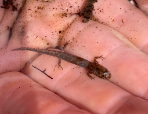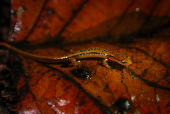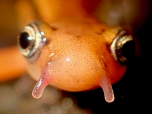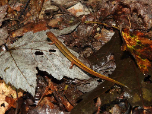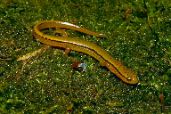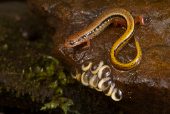Blue Ridge Two-Lined Salamander (Eurycea wilderae)
Description: The Blue Ridge two-lined salamander ranges in size from 2 3/4 - 4 1/2 inches and ranges in color from bright yellow, yellow-orange, to orange. There are two black dorsolateral lines that usually break into dots or blotches around the middle of the tail. There are often scattered black dots on the back. The Blue Ridge two-lined salamander has a relatively long tail as it is between 55-60% of the total length. There are generally 14 to 16 costal grooves, based on elevation. At a lower elevation, 14 costal grooves is more common. Nasolabial grooves, also known as cirri, are common.
Habitat: Within those mountains they will be found along streams and forested habitat. The mating season will usually determine if they are discovered in more of a terrestrial or aquatic habitat. It is not well documented if this species migrates further than from terrestrial to aquatic habitats. They are lungless and require environments that are moist and cool (Crawford 2016). The streams that are more suitable for the Blue Ridge two- lined salamander contain submerged substrate to oviposit. When this salamander is not breeding they will burrow, typically under logs and leaf litter.
Range: The Blue Ridge two-lined salamanders have been reported to the southern Appalachian Mountain range.
Diet: Their diet is very similar to other terrestrial salamanders. Both the aquatic juveniles and terrestrial adults have been documented eating copepods, midge larvae, nematodes, and both aquatic and terrestrial insects. The size of the prey items depends on the salamander's size and growth rate.
Reproduction: The Blue Ridge two-lined salamander is an external fertilizer. Its oviposition usually occurs during late winter or early spring months. The female deposits eggs under rocks, logs, or leaves in water which they will then guard until the eggs hatch. Hatchlings emerge with external gills and spend around 2 years fully aquatic larvae before transforming into adults. When the larvae begin to metamorphosize is largely dependent on temperature and food availability. Those exposed to higher temperature will metamorphosize sooner. In contrast those that had more food grew a lot larger and waited longer before metamorphosizing. Evidence suggests direct-development was the ancestral form of development, with the metamorphic life cycle being an example of metamorphic deceleration.
There is sexual dimorphism between two types of males: searching males and guarding males. Searching males have cirri, mental glands, and protruding premaxillary teeth, which are adapted for locating and courting females in terrestrial habitats. Guarding males lack these characteristics and instead have seasonally enlarged jaw musculature adapted for defending females at aquatic nesting sites.
Status: Listed as Least Concern in view of its wide distribution and presumed large population.
»» Kingdom: Animalia - Animals
»» Phylum: Chordata - Chordates
»» Subphylum: Vertebrata - Vertebrates
»» Class: Amphibia - (Amphibians)
»» Order: Caudata - Salamanders
»» Family: Plethodontidae - Lungless Salamanders
»» Genus: Eurycea
»» Species: Eurycea wilderae - Blue Ridge Two-Lined Salamander
This article uses material from the Wikipedia article "Blue Ridge Two-Lined Salamander", which is released under the Creative Commons Attribution-Share-Alike License 3.0. Content may have been omitted from the original, but no content has been changed or extended.
|


